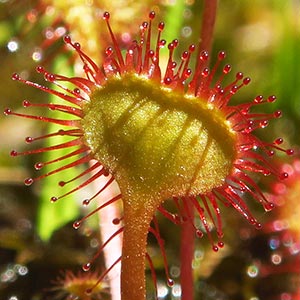Drosera rotundifolia
Drosera capillaris
droséra à feuilles rondes, round-leaf sundew
pink sundew
erect to prostrate;
stipules adnate to petioles their entire length, 4–6 mm, margins fimbriate along distal 1/2;
petiole differentiated from blade, 1.5–5 cm, glandular-pilose;
blade suborbiculate, 0.4–1 cm × 5–12 mm, broader than long, much shorter than petiole.
prostrate;
stipules free from or adnate to petioles to 1 mm, then breaking into setaceous segments 3–5 mm;
petiole differentiated from blade, 0.6–4 cm, sparsely glandular-pilose;
blade broadly spatulate to orbiculate, 0.5–1 cm × 3–5 mm, usually at least slightly longer than broad, usually shorter than petiole.
2–15(–25)-flowered;
scapes 5–35 cm, glabrous.
2–20-flowered;
scapes 4–20(–35) cm, glabrous.
4–7 mm diam.;
sepals connate basally, oblong, 4–5 × 1.5–2 mm, glabrous;
petals white or pink, spatulate, 5–6 × 3 mm.
10 mm diam.;
sepals connate basally, oblong-elliptic, 3–4 × 1–2 mm, apex obtuse, glabrous;
petals usually pink, sometimes white, obovate, 6–7 × 2–3 mm.
5 mm.
4–5 mm, longer than sepals.
light brown, fusiform, 1–1.5 mm, finely and regularly longitudinally striate, with metallic sheen.
brown, ellipsoid to oblong-ovoid, asymmetric, 0.4–0.5 mm, coarsely papillose-corrugated, 14–16-ridged.
= 20.
= 20.
Drosera rotundifolia
Drosera capillaris
Drosera rotundifolia was the carnivorous plant most studied by C. Darwin (1875). The species is circumboreal and is widespread across North America, much more common northward and rarer in the South. It is difficult to grow in warmer climates.
M. L. Fernald (1950) recognized forma breviscapa (Regel) Domin, found in the Canadian Maritime Provinces, with scapes 1–4 cm long and 1–3 flowers, and var. comosa Fernald, found from Gaspé County, Quebec, to New England and northern New York, with the parts of the flowers modified to green gland-bearing leaves. Dwarf, few-leaved plants found in Alaska have been called var. gracilis Laested.
(Discussion copyrighted by Flora of North America; reprinted with permission.)
Drosera capillaris is the most-frequently encountered species of the genus in the South in moist habitats that can support carnivorous plants, especially in fire-maintained pinelands. Plants can be quite small, or form surprisingly large and robust rosettes (to 12 cm broad) in some places along the Gulf Coast. It is disjunct from the Coastal Plain to Arkansas and Tennessee, as are several other species from coastal wetland habitats. Since the leaf blades of D. capillaris can be somewhat orbiculate, it may be confused with the much more northern D. rotundifolia, which grows more typically in sphagnum (although in its northern range it often grows on moist sand substrates), has adnate stipules, white flowers, and forms hibernaculae.
Drosera capillaris is easy to grow, often behaving as an annual.
(Discussion copyrighted by Flora of North America; reprinted with permission.)
- Local floras:
BC,
CA,
OR,
WA
- Local Web sites:
CalFlora,
CalPhotos,
Flora NW,
Go Botany,
IL Wildflowers,
MD Biodiversity,
MI Flora,
MN Wildflowers,
PNW Herbaria,
Turner Photog.
WildflowerSearch
iNaturalist (observations)
USDA Plants Database
- LBJ Wildflower Center
- SEINet
- Plants of the World Online
- Encyclopedia of Life
- Wikipedia
- Google Image Search


